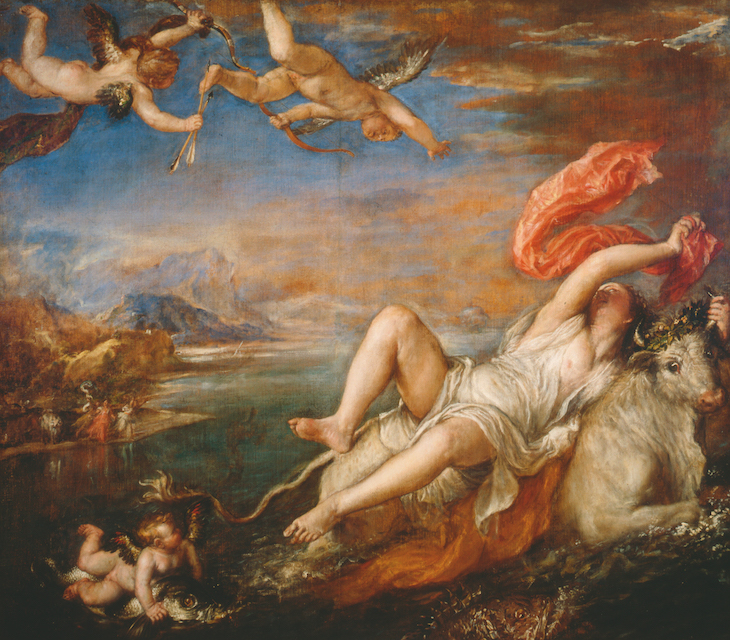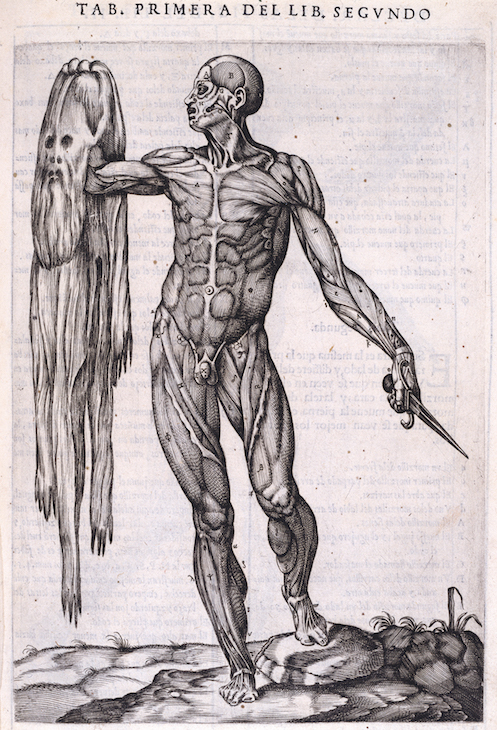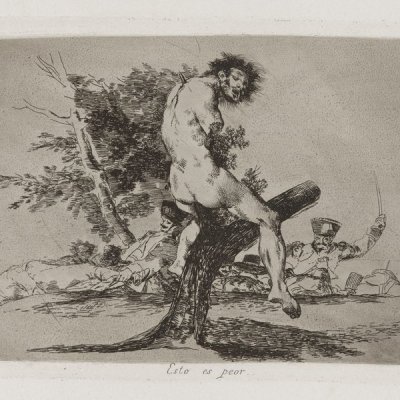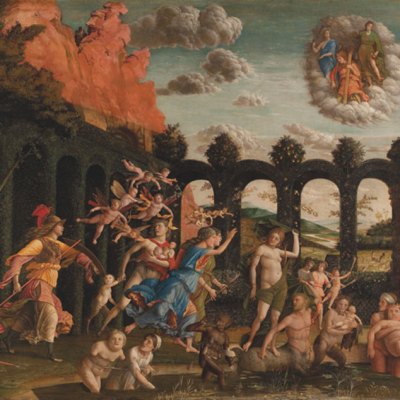Among the telling anecdotes about the place of Ovid in the imaginations of Renaissance artists is a story about Andrea Mantegna told by the poet Antonio Tebaldeo. While so ill that he and those around him believed he would die, Mantegna begged for a particularly beautiful statue he had heard of to be brought to him. On touching it, he was cured. Turning to those present he said:
O wonderful hand of the maker, which not only gives this
stone life,
but gives it the power to
give life. Your stones must yield,
Deucalion!
They were given life, but these ones, given life, are life-giving too.
The reference is to the first book of Ovid’s Metamorphoses, where, in a world destroyed by the Flood, Deucalion and his wife Pyrrha create a new race of men. They walk, throwing stones over their shoulders and the stones ‘lose their hardness and stiffness, become soft, and once soft take on form’. In the middle of the process, they look like ‘statues just begun’. A miracle, by any measure. But for Mantegna, the sculptor whose statue he had touched went one stage further: animated by the maker’s hand, it in turn reanimated Mantegna.
Even if Mantegna’s miraculous cure-by-statue seems too good to be true, it shows how prominent a place Ovid held in the artist’s imagination. He was not alone in his fixation. From Mantegna himself, to Piero di Cosimo, Pollaiuolo, Botticelli, to Titian’s Poesie – to name only a few – the Metamorphoses was the ultimate sourcebook for artists. In art from the 15th through to the 17th centuries, where there is myth, it is almost guaranteed to be Ovidian in some shape or form – even if, as Malcolm Bull pointed out in Mirror of the Gods, the countless mythographical handbooks, epitomes and emblem collections of the period meant that artists’ borrowings were often unconscious or indirect. Furthermore, as Mantegna’s playful inversion of the Deucalion story shows, the Metamorphoses were a source of art theory too. Deucalion is just one of many artists Ovid shows transforming and animating materials in new ways: Pygmalion, Orpheus, Arachne, Marsyas…the list goes on. Metamorphosis is not just Ovid’s theme, it is also his modus operandi; something that, as Mantegna’s exclamation shows, Ovid’s artist-inheritors were well aware of.
This year marks 2,000 years since Ovid’s death: Ovid himself would be pleased, if immodestly unsurprised, at the range and duration of his influence. In the visual arts alone, it runs from the handsomely illustrated manuscripts of the 14th-century Ovide moralisé, through the vast Ovidian visual culture of the Renaissance, and on into modern inheritors as diverse as Picasso, Anish Kapoor, and Chris Ofili. While Ovid could hardly have predicted this much, he had reason to believe his name would live on, at least when he finished writing the Metamorphoses. By the time he came to write the epic, he was already the most famous poet in Rome – a prominence due in no small part to the scandalous brilliance of his love poetry in the Amores, Ars amatoria and Remedia amoris – and his most ambitious work yet was designed to cement that fame for good. As he boasted in the Metamorphoses’ epilogue:
Now I have finished my work, which neither Jove’s rage,
nor fire,
nor sword, nor the gnawing tooth of time shall ever be able
to destroy.
[…]
Wherever Rome’s power extends over conquered lands,
I will be read in the mouths of men, and through all ages,
If the prophecies of poets have any truth, I will live on.
In the event, Ovid’s confidence was short-lived: in 8 AD, the year he completed the Metamorphoses, he was banished from Rome. We will never know what his crime was precisely (his own phrase carmen et error, ‘a poem and a mistake’, is tantalisingly uninformative), but at the Emperor’s personal instigation he was exiled to live out the last decade of his life on the edge of the Empire, in Tomis, where he wrote his last works, the Tristia and Epistulae ex Ponto. His grief was such that before he left, he took his own manuscript of the Metamorphoses and burned it. The poem comes down to us, it seems, thanks to the copies already circulating among Ovid’s friends. And while an older, more sanguine Ovid appears to have been grateful for the survival, he asked anyone who should read it to remember that it was not, as far as he was concerned, finished. They should, he said, be indulgent of any faults, for it was ‘still growing’, a ‘rough poem’ unpolished by its author.
It is hard to overstate how little the Metamorphoses resembles any such thing. On the one hand, it is astonishing for its sheer compendiousness. Running ab origine mundi right up to the time of Julius Caesar, Ovid’s epic weaves around 250 different myths together into a single ‘unbroken song’. No other classical text comes close. To medieval readers it looked like ‘nothing less than the Bible and theology of the pagans’ – the master key to all their culture and knowledge. And, in ways that proved vital for artists, the Metamorphoses’ compendiousness encouraged scholars and translators from the 12th century onwards to create a gamut of Ovidian epitomes and expansions. From the vast Ovide moralisé, adding tales and morals to make a translation some 12 times longer than the original, to the cribbing guides and emblem books designed to fit into 16th-century pockets, the Metamorphoses was available through a wider range of surrogates than any book except the Bible.
Las Hilanderas (c. 1655–60), Diego Rodríguez de Silva y Velázquez. Museo del Prado, Madrid

Readers who came to the Metamorphoses first-hand, meanwhile, met a self-conscious tour de force of poetic ingenuity. Ovid himself coined the term narrabilis, ‘narratable’, and his epic is always pushing at the boundaries of what can and cannot be told; pushing his way into new methods of unfolding old tales. In its quest to do this, Ovid’s narration weaves back and forth through mythic time, nesting tales within tales, and tellers of tales within tellers of tales, to the level where a given story might be occurring within as many as five sets of other stories. Tales told in the poem frequently take place within inverted commas within inverted commas, several times over. And in this way, from the poem’s opening invocation onwards, metamorphosis and citation go hand in hand – as much a methodology as a mythical theme. This was something only reinforced by the countless metamorphoses and acts of citation that the poem went through in all its secondary forms. Ovid’s artistic inheritors came to an epic that persistently changed and renewed its own voice and point of view; and which, in turn, kept being changed, renewed, and revoiced by the ever-growing corpus of vicarious works that sounded it.
Nowhere is an artist’s understanding of Ovidian nesting and citation better illustrated than in Velázquez’s Las Hilanderas (The Spinners, c. 1655–60), where what looks at first like an everyday scene turns out to be a mise en abîme of Ovidian citation. Look beyond the women industriously spinning their thread in the foreground, and one sees through into the next room, decked with the luxurious tapestries that are the final product of the process; look more closely and you can make out that the visible tapestry is a copy of Titian’s Europa (1560–62). The subject gives the riddle of the painting away. In the sixth book of the Metamorphoses the young weaver Arachne finds herself in a weaving competition against Athena, disguised as an old woman. They each weave a series of mythological scenes; Arachne starts with Europa, tricked by Jove disguised as a bull. So realistic is the tapestry, Ovid writes, that ‘you would think it a real bull and real waves’ lapping at the maiden’s feet – just as Titian’s painting presents the scene. Once that falls into place, some – if not all – of Velázquez’s painting’s mysteries are revealed. To the left, inscrutable, is Athena in her disguise; on the right sits Arachne. If Athena’s identification is equivocal – she is in disguise after all – Arachne, with the bright light falling on her arm and the curve of her neck, and the delicate flick of her hand, appears just as Ovid describes her: ‘so graceful in her craft […] winding the rough yarn into a ball’.
Europa (c. 1560–62), Titian. Isabella Stewart Gardener Museum, Boston

Velázquez does not give us the metamorphosis that Arachne is doomed to undergo in the poem – turned into a spider as she hangs herself to escape the jealous goddess’s spite – but the entire painting is an eloquent transformation. Pulled over from poetry into paint, the Greek goddess and the Maeonian girl have become 17th-century Spanish craftswomen, whose wares are destined for the noblewomen Velázquez shows viewing the tapestry. But the real depth comes from the tapestry itself. To recognise the scene from Velázquez’s rendering – distant, blocked by the painting’s internal audience of young women – you would have to know either Titian’s painting or Rubens’ later copy of it. In other words, you would have to recognise that you are looking at a painting of a tapestry of a painting; a painting which, in the first place, is of a myth narrated by a tapestry woven inside of a poem. As in the mirrorings of Las Meninas, from the same period of Velázquez’s career, the effect is vertiginous. But it is also domestic: the referentiality of it all is an in-joke for Philip IV, who could, any time he wished, walk down his hallway to see the original Titian.
Nor, if one is even slightly etymologically minded, does it stop there: when we talk of the ‘text’, we are unwittingly indulging in a metaphor that runs throughout the Arachne story. ‘Text’, from textus, literally means ‘woven’; the details of Ovid’s tapestries are intertextos, ‘interwoven’; like Velázquez’s painting, their real artfulness comes from their situation in relation to a web that seems to spool out infinitely. Ovid, Titian, Velázquez, and perhaps Rubens too, are involved in a kind of artistic game that has no natural end; one that may have a threat lurking within it. As so often in the Metamorphoses, Arachne’s tale is both an aetiology and a warning: artists can be too talented for their own good. Just as Ovid found out himself, great talents can suffer dire consequences at the hands of those more powerful than them. When Athena shakes off her disguise, Arachne does not take the hint to desist, and ‘stupid in her desire for victory rushes toward her fate’. It is worth asking if Velázquez too is squaring off against someone. Is it Ovid, Titian, or Rubens? Or is it an oblique statement on Philip, his friend, but above all his patron and master – a relationship that 16th-century commentators frequently saw behind Ovid’s tales of artistic comeuppance? Or is this, for all the invitations that Las Hilanderas extends, going too far? It may be, but if, at a certain limit, the interpretations one places on the painting hang only by the slenderest thread, in the context of Arachne’s fate, that, surely, is the point.
The metaphors that inevitably attend on Arachne – unspooling, weaving, webs of meaning – are almost too fecund for their own good. With Las Hilanderas, Velázquez’s traceable intentions – his own indulgence in the kinds of meta-artistic games Ovid likes so much – take us a long way, but they by no means exhaust the richness of what is going on. And the manner in which the web of influence and meaning extends beyond Velázquez’s conscious intentions points to much of what is so interesting about Ovid’s absorption into art: that his traces reappear time and time again with or without conscious effort on the part of individual artists. After a while, one begins to see the Metamorphoses even in the most unlikely of places. The poem seems to pass through Renaissance art as much by a kind of metempsychosis – ‘transmigration of soul’ – as through conscious effort on the part of individual artists. As Ovid puts it in the long speech by Pythagoras that dominates the Metamorphoses’ final book:
Nothing keeps its own appearance, Nature, renewer of things,
prepares new shapes from other shapes:
believe me, nothing in this whole world perishes,
but only varies and changes its face.
Statue of Apollo with the skin of Marsyas, from Galleria Giustiniana del Marchese V.G, (c. 1936), Joachim von Sandrart; engraved by Theodor Matham. Rijksmuseum, Amsterdam

Perhaps no Ovidian tale’s uptake in Renaissance art is more indicative of this kind of transmigration of souls than that of the satyr Marsyas. Another of Ovid’s doomed artists, Marsyas makes the error of competing against Apollo, god of music, in a musical contest. Apollo wins, but unsatisfied with victory alone, the wrathful god skins Marsyas alive. The most famous visual version of the scene in paint is, without a doubt, Titian’s: a dark and impressionistic swirl, with a limp Marsyas dangling in its centre, like a dead deer being dressed by its hunters. It is an extraordinary piece, but the detail is to be found everywhere except in Marsyas’s body: Apollo leaning in with his knife, as intent as a surgeon; the spaniel lapping at the blood; the pipes dangling from the tree. Marsyas himself is curiously resigned, looking at the viewer with an unreadable stare. For all its drama and brilliance, it is a long way from the physical fixation of the poem on Marsyas’s body:
As he screams the skin was torn off the surface of his body,
until he was nothing but a wound; blood flows all over,
his muscles are uncovered and exposed, his shivering veins
without skin shake; you could number the guts twitching
and the entrails shining through his chest.
It is hard to read this and not be reminded of the flowering of anatomical art that occurred in the 16th century. While Titian did not care to, there were many artists interested in precisely the numbering of parts that Ovid’s horror-struck reader is asked to engage in. The same bodily paradox that Ovid mines for horror and pathos becomes in their hands a principle of discovery and dispassion: the écorché, suspended skinless somewhere between life and death to show exactly how it is that human life functions. Like the ‘muscle men’ whose presence accompanied the 16th century’s interest in anatomical learning and illustration, Marsyas is alive, and on view – all but literally labelled in all his parts, like the animated corpses who wander through the pages of Andreas Vesalius’s groundbreaking De humani corporis fabrica (1543).
In Vesalius’s manual, the coincidence is just that, but the artist behind the original woodcuts in a later manual seems haunted by the Ovidian echo. The first écorché in Juan Valverde’s 1556 Historia de la composicion del cuerpo humano stands as if having flayed himself – his knife in one hand, his own skin in the other. While many of the plates are copied directly from Vesalius, this one is not; and it and the other originals, etched in Rome by Nicolas Béatrizet (possibly from drawings by Gaspar Becerra) are haunted by Roman archetypes. Torsos opened to the intestines are presented wearing Roman armour; a figure courteously lifting his skin to show the ribs beneath wears Hercules’ lion skin on his head. The full-body écorché is its own metamorphosis: its pose is a mirror image of a statue of Apollo on display in Rome, knife in one hand, Marsyas’s skin in the other. The poem’s impromptu anatomy lesson, provided by a god, becomes a real anatomy lesson, where the god and the flayed man have become the same figure.
A flayed man holding his own skin, from Juan de Valverde de Amusco’s Historia de la composicion del cuerpo human (1556), 1556, Gaspar Becerra. Royal Academy of Arts, London

The direction of flow reverses at last in Melchior Meier’s startling depiction of the Metamorphoses scene – an etching that returns all the anatomical detailing of Vesalius and Valverde’s manuals to the world of the myth. Apollo, in the same statue pose, shows the satyr’s hirsute hide to a terrified king Midas – equipped with the asses ears of his own punishment. But the corpse on the left, sliding down its tree is a man’s, not a satyr’s: an elaborately posed écorché straight from the textbooks; muscles ready to be counted. He is a Marsyas copied into a world of Ovid straight from an anatomical textbook: one figure, becoming another, becoming, but only nearly, itself again.
What Meier’s etching brings to life is the crux of Ovid’s reception in art. Look elsewhere and one sees that not only has Marsyas transformed – turned from satyr to human by his passage through the anatomy books – but the whole tale has changed around him. Those who know their myths will recognise that Midas, equally important to Apollo and Marsyas in Meier’s composition, should not be there at all. He and his ears, received from Apollo for misjudging another musical competition, belong to another tale, and another book of the Metamorphoses. But the material has a life of its own, and for all his anatomical precision of technique, Meier is not in control of its potential for change. He, like so many 16th-century readers, has confused the two stories, and turned them into one. It is the kind of thing you would be tempted to call a mistake, except, as the etching shows, such metamorphoses are inevitable. From Midas’s armour and sword, sprouting their own grotesque faces, to the bulging eyes of the stump he steadies himself on, to the way Marsyas’s muscles blend with the sinewy limbs of the tree, everything is on its way to becoming something else. And this kind of flux is pure Metamorphoses: a history of transformations, willed and unwilled, continuing without cease. Meier’s etching illustrates not just a tale from Ovid, but the tale of Ovid’s afterlife in art, where ‘Nothing keeps its own appearance’.
From the April 2017 issue of Apollo: preview and subscribe here


